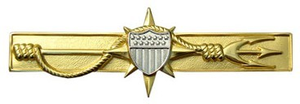
Marine Safety Insignia
Encyclopedia

Petty Officer Third Class
U.S. NavyGood conductvariationU.S. NavyPetty officerthird classinsigniaPetty officer third class is the fourth enlisted rank in the U.S. Navy and U.S. Coast Guard, just above seaman and below petty officer second class, and is the lowest rank of non-commissioned officer, equivalent to a corporal in...
and above) and officers of the United States Coast Guard
United States Coast Guard
The United States Coast Guard is a branch of the United States Armed Forces and one of the seven U.S. uniformed services. The Coast Guard is a maritime, military, multi-mission service unique among the military branches for having a maritime law enforcement mission and a federal regulatory agency...
and United States Coast Guard Reserve
United States Coast Guard Reserve
The United States Coast Guard Reserve is the reserve component of the United States Coast Guard. It is organized, trained, administered, and supplied under the direction of the Commandant of the Coast Guard through the Director of Reserve and Leadership....
, to Coast Guard Civilians, and to members of the United States Coast Guard Auxiliary
United States Coast Guard Auxiliary
The United States Coast Guard Auxiliary is the uniformed volunteer component of the United States Coast Guard and was established on June 23, 1939 by an act of Congress as the United States Coast Guard Reserve, and was re-designated as the United States Coast Guard Auxiliary on February 19, 1941...
to recognize professional accomplishment in the Marine Safety program. In addition, the United States Coast Guard Auxiliary
United States Coast Guard Auxiliary
The United States Coast Guard Auxiliary is the uniformed volunteer component of the United States Coast Guard and was established on June 23, 1939 by an act of Congress as the United States Coast Guard Reserve, and was re-designated as the United States Coast Guard Auxiliary on February 19, 1941...
has a similar award called the Auxiliary Marine Safety (Trident) Device as part of the Auxiliary's Marine Safety Trident Program.
History
Admiral James LoyJames Loy
Admiral James Milton Loy served as Acting United States Secretary of Homeland Security in 2005 and United States Deputy Secretary of Homeland Security from December 4, 2003, to March 1, 2005...
, as Commandant of the Coast Guard
Commandant of the Coast Guard
The Commandant of the United States Coast Guard is the highest ranking member of the United States Coast Guard. The Commandant is normally the only four-star Admiral in the Coast Guard and is appointed for a four-year term by the President of the United States upon confirmation by the United...
, approved the creation of the Marine Safety Insignia on November 2, 2000 to recognize the professional accomplishment of personnel in the Coast Guard's Marine Safety Program. The Commandant presented Rear Admiral Robert C. North, then-Assistant Commandant for Marine Safety and Environmental Protection, with the first Marine Safety Insignia on April 10, 2001, who accepted it "on behalf of all the marine safety professionals past, present, and future." Admiral North then presented the second Marine Safety Insignia to Master Chief Bell, the Marine Science Technician Rating Force Manager.
Description
On the original Insignia criteria information sheet, the description and symbolism of the Marine Safety Insignia is explained:Criteria
To receive the Marine Safety Insignia the member must earn four marine safety competencies. To earn the permanent version of the insignia, the member must also serve a cumulative five years at marine safety field units. The list of marine safety competencies and definition of a "marine safety field unit" is detailed on the Coast Guard's CG Portal intranet webpage.Temporary entitlement may be issued by the commanding officer of a marine safety field unit to a member who has received four marine safety competencies and completed the marine safety initial indoctrination training program but who has not been assigned to a marine safety field unit for at least five years. The temporary entitlement is for the period that the member is permanently assigned to that unit.
Insignia guidance and references
The first detailed information on the Marine Safety Insignia was announced in ALCOAST 183/01. More guidance was included in ALCOAST 295/01. Updated guidance was announced in ALCOAST 192/10, which changed the marine safety field unit service requirement for permanent award from four years to five, and updated the criteria to reflect modified qualification codes and the adoption of the Sector organizational structure.Policy regarding the Marine Safety Insignia is found in Chapter 4.B.4 of the Coast Guard Enlisted and Officer Accessions, Evaluations, and Advancements Manuals. The insignia must be worn in accordance with Chapter 3.E.1 of the Uniform Regulations Manual.
Auxiliary Marine Safety (Trident) Device

United States Coast Guard Auxiliary
The United States Coast Guard Auxiliary is the uniformed volunteer component of the United States Coast Guard and was established on June 23, 1939 by an act of Congress as the United States Coast Guard Reserve, and was re-designated as the United States Coast Guard Auxiliary on February 19, 1941...
has a similar device called the Auxiliary Marine Safety (Trident) Device. This device is awarded after completion of:
- The following marine safety courses: Introduction to Marine Safety and Environmental Protection; FEMA Emergency Management Institute Courses ICS 100, ICS 200, ICS 210 or ICS 300, IS 700 and IS 800; and the Ocean Conservancy Good Mate Course.
- Four Performance Qualification Standards (PQS) as described in the USCG Auxiliary Marine Safety Performance Qualification Standards.
- Five years of service in Marine Safety & Environmental Protection missions (consisting of at least 96 hours of service per calendar year); however, a conditional award of this device may be awarded based on a recommendation from the local USCG Captain of the Port if all aforementioned requirements are met other than the five years of service.

